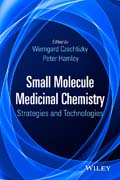
Small Molecule Medicinal Chemistry: Strategies and Technologies
Czechtizky, Werngard
Hamley, Peter
Stressing strategic and technological solutions to medicinal chemistry challenges, this book presents methods and practices for optimizing the chemical aspects of drug discovery. Chapters discuss benefits, challenges, case studies, and industry perspectives for improving drug discovery programs with respect to quality and costs. Focuses on small molecules and their critical role in medicinal chemistry, reviewing chemical and economic advantages, challenges, and trends in the field from industry perspectives Discusses novel approaches and key topics, like screening collection enhancement, risk sharing, HTS triage, new lead finding approaches, diversity–oriented synthesis, peptidomimetics, natural products, and high throughput medicinal chemistry approaches Explains how to reduce design–make–test cycle times by integrating medicinal chemistry, physical chemistry, and ADME profiling techniques Includes descriptive case studies, examples, and applications to illustrate new technologies and provide step–by–step explanations to enable them in a laboratory setting INDICE: IntroductionPart I Exploring Biological Space: Access to new Collections1. Elements for the Development of Strategies for Compound Library EnhancementEdgar Jacoby1.1 Introduction1.2 Chemical space for drug discovery1.3 Molecular properties for drug discovery1.4 Major compound classes1.5 Chemical Design Approaches to expand Bioactive Chemical Space1.6 ConclusionAcknowledgementsReferences2. The European Lead Factory Christopher Kallus, Jörg Hüser, Philip S. Jones, Adam Nelson2.1 Introduction2.2 Building the Joint European Compound Library2.3 Qualified Hit Generation2.4 Future perspectivesAcknowledgementsReferences3. Access to Compound Collections New Business Models for Compound Acquisition and SharingPeter ten Holte3.1 Introduction3.2 Risk–sharing approaches3.3 Library exchange3.4 Sharing collections for external screening3.5 ConclusionAcknowledgementsReferencesPart II Exploring Biological Space: Access to new Chemistries4. New Advances in Diversity–Oriented SynthesisWarren R. J. D. Galloway, Jamie E. Stokes, David R. Spring4.1 Introduction: small molecules and biology4.2 The need for structural diversity in synthetic small molecule screening collections4.3 Diversity–oriented synthesis of new structurally diverse compound collections4.4 Concluding remarksReferences5. Solid–phase combinatorial chemistry: ready for a revival?Marcel Patek, Martin Smrcina, Eric Wegrzyniak, Victor Nikolaev, Andres Mariscal5.1 Chapter outline5.2 Combinatorial chemistry in retrospect5.3 Foundations of solid–phase synthesis of combinatorial chemistry5.4 The outcome of Tucson combinatorial chemistry at Sanofi5.5 Conclusions and outlookReferences6. Recent Advances in Multicomponent Reaction Chemistry: Applications in Small Molecule Drug DiscoveryChristopher Hulme, Muhammad Ayaz, Guillermo Martinez–Ariza, Federico Medda, Arthur ShawIntroductionSummaryPart III Screening Strategies7. Computational Techniques to Support Hit TriageDouglas B. Kitchen, Hélène Y. Decornez7.1 Lead finding process: overview and challenges7.2 Chemical structure analysis of hit lists7.3 Rules and filters7.4 Triage systems7.5 Ligand efficiency indices7.6 Hit series analysis7.7 SummaryReferences8. Fragment–Based Drug DiscoveryJean–Paul Renaud, Thomas Neumann and Luc Van Hijfte8.1 Introduction8.2 Fragment libraries8.3 Biophysical screening technologies8.4 Fragment evolution strategies8.5 FBDD case studies8.6 The futureReferences9. Virtual ScreeningKarl–Heinz Baringhaus, Gerhard Hessler9.1 Introduction9.2 Databases and database preparation9.3 Validation of the virtual screening strategy9.4 Ligand–based virtual screening9.5 Structure–based virtual screening9.6 Other virtual screening applications9.7 ConclusionReferences10. Phenotypic ScreeningMichelle Palmer10.1 Introduction10.2 History and past successes10.3 Impact of phenotypic screening10.4 Model systems for phenotypic assays10.5 Assays10.6 Deorphaning10.7 SummaryReferencesPart IV Technologies for Medicinal Chemistry Optimization11. Advances in the Understanding of Drug Properties in Medicinal ChemistryPeter Hamley, Patrick Jimonet11.1 Introduction11.2 Properties and origins of marketed drugs11.3 Drug properties and attrition in clinical development11.4 The rule–of–five11.5 The concept of lead–likeness11.6 Influence of drug properties on absorption, distribution, metabolism, excretion and toxicity (ADMET)11.7 Building on the Ro5: new guidelines for compound design11.8 Alternatives, criticisms and exceptions11.9 ConclusionsReferences12. Recent Developments in Automated Solution Phase Library ProductionThomas C. Maier, Werngard Czechtizky12.1 Introduction12.2 Library Production12.3 New Technologies in Automated Liquid–Phase–Library Synthesis12.4 Flow chemistry and gas–phase reactions12.5 ConclusionReferences13. ADME Profiling An Introduction for the Medicinal ChemistKatharina Mertsch, Martin Will, Werngard Czechtizky, Niels Griesang, Alexander Marker, Jacob Olsen13.1 Introduction13.2 Compound Profiling in H2L optimization13.3 Compound Profiling in Lead optimization13.4 Integration of Medicinal Chemistry, Biology, physicochemical and ADME Profiling Strategies towards Cycle Time Reductions13.5 SummaryReferencesPart V Medicinal Chemistry beyond Small Molecules14. The Role of Natural Products in Drug Discovery Examples of Marketed DrugsLars Ole Haustedt and Karsten Siems14.1 Natural products and natural product derivatives in commercial drugs14.2 Hit to lead optimization of natural product hits14.3 Case Study 1 – Taxol14.4 Case Study 2 – Epothilone14.5 Case Study 3 – Eribulin14.6 Case Study 4 Geldanamycin14.7 Case Study 5 – Ingenol mebutate (Picato)14.8 SummaryReferences15. Peptidomimetics of a–helical and b–strand protein binding epitopesNina Bionda, Rudi Fasan15.1 Protein–Protein Interactions as Therapeutic Targets15.2 Peptidomimetics of –helical protein binding epitopes15.3 Peptidomimetics of b–strand protein binding epitopes15.4 ConclusionReferences16. In vivo Imaging of Drug ActionOliver Plettenburg, Matthias Löhn16.1 Introduction16.2 Overview of imaging methods16.3 Imaging of therapeutic effects16.4 Conclusion and outlookReferencesIndex
- ISBN: 978-1-118-77160-0
- Editorial: Wiley–Blackwell
- Encuadernacion: Cartoné
- Páginas: 528
- Fecha Publicación: 27/11/2015
- Nº Volúmenes: 1
- Idioma: Inglés
